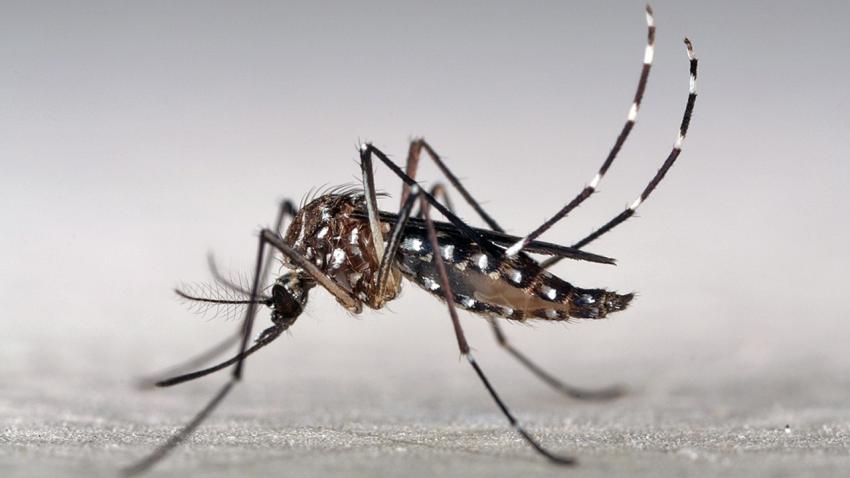The Zika Beat: Observations of a Mosquito Man
By Arelisa Daniels
Reporting Texas

The mosquito that carries the Zika virus, Aedes aegypti, is commonly found throughout southern United States. Photo courtesy Marcos Teixeira de Freitas/Creative Commons
Since reports emerged from Brazil earlier this year suggesting a link between the Zika virus and serious birth defects, epidemiologists have tracked the spread of the disease northward to the United States. A small but growing number of cases in the U.S. has prompted the Centers for Disease Control in Atlanta to advise pregnant women not to travel to heavily infected areas in Latin America and thereby complicated Brazil’s plans to host the 2016 Summer Olympics in Rio De Janeiro. In Texas, attention has turned to concerns about the mosquito’s role in spreading the disease, especially with a second Zika case confirmed in Austin.
Reporting Texas’ Arelisa Daniels spoke with Jeff Tomberlin, associate professor of entomology and director of the Forensic and Investigative Sciences Program at Texas A&M University. Tomberlin’s research into novel ways to prevent mosquito bites is particularly timely in the wake of the Zika outbreak. Excerpts:

Professor Jeff Tomberlin
Q. Were you surprised by the recent Zika outbreak?
A. I was not surprised in terms of a pathogen being distributed by mosquitoes, considering the global economy and how easily things are moved around. It’s very difficult to keep everything out [of the U.S.]… in such a global society.
Q. Why should people want to know about the mosquito’s role in spreading the virus?
A. If we understand the biology of the vector, then we can control the vector better and therefore decrease the likelihood of infection.
Q. The Aedes aegypti mosquito is considered a prime vector for Zika. Why?
A. It is common throughout the southern U.S. It’s what you would call a tree-hole mosquito. It likes to lay its eggs in areas where water will accumulate. [When the weather is] dry, the eggs can persist in the environment until rainfall. [At that point] development is relatively quick and the females [become] the vector for a number of pathogens, including those that cause yellow fever and dengue [fever].
Q. Reports suggest the Asian tiger mosquito is a second vector for Zika in Texas. Would your research results apply to the tiger mosquito as well?
A. Yes – in fact, that mosquito is our model for developing the technology.
Q. How good a job has the news media done in reporting on the spread of the Zika virus?
A. There’s no reason to create a scare or over-exaggerate the concern, or under-exaggerate, so we have to be careful about what is said. But yes, I think media should be involved. I think that is the easiest way to get information out to the general public.
Q. Is Texas is more susceptible than other places when it comes to mosquito-borne illnesses?
A. Given the environment we live in—the Southern U.S [with its] warm weather— it would not surprise me that we see a higher prevalence of the pathogen here than, say in a colder environment. For example, in Ohio or Michigan, it’s cold so we don’t have mosquito populations up there right now.
Q. Is climate important in other ways?
A. As climate change occurs, we’ll see mosquito populations potentially disperse to other areas where it normally wouldn’t occur. Their persistence in the environment could be for a greater period of time.
Q. Talk about your research. What’s your basic approach?
A. If we take a step back and look at ourselves as more of an ecosystem, then new opportunities will develop for how to regulate [whether mosquitoes are attracted] to us, because there is more involved than just our physiology. There’s the physiology of the microbes that are associated with our bodies, as well. So, there’s potential for us to develop novel methods for manipulating the microbes on our body, which could alter [mosquitos’] perception of us as food resources. It’s realistic to think we can find novel methods for mosquito control.
Q. What might a realistic timeline be?
A. While we have discovered this [kind of prevention] can be done, we’re still in the first phase. We need to move over to the second phase, actually applying the technique. I would say we’re still potentially a year or two down the road from actual application, but that also takes getting the industry interested and willing to pursue these opportunities.
Q. How might your bite-prevention technique be implemented?
A. We were thinking as a wipe or sunscreen.
Q. How has the Zika outbreak affected your research?
A. We are now examining the response of mosquitoes to different concentrations of bacteria that can communicate or not. This work is not in response to Zika virus, but definitely related.
Q. Are conventional methods of mosquito prevention sufficient?
A. They only represent part of the solution. Primary efforts need to utilize an integrated pest management approach. We could develop technologies that reduce mosquito attraction without being harmful to the beneficial bacteria on our skin.
Q. How else might your research results be used?
A. We might be able to develop traps for adult mosquitoes looking for a meal or place to lay eggs. This work could apply to any other blood-feeding arthropod (black flies, sand flies etc).